Optimize Your Ecommerce Marketing Costs with These 6 Best Practices and Metrics

After a tremendous pandemic surge, ecommerce sales continue to increase. According to Insider Intelligence, global ecommerce sales are predicted to hit nearly $7.5 trillion by 2025, up 33% from 2022’s $5.5 trillion.
With so many retailers rushing to create online stores to grab a slice of this booming market, ecommerce marketing costs have soared as brands compete for customers. Namagoo’s 2022 Annual Global Ecommerce Leaders Survey reveals that 61% of leaders surveyed cite “cost optimization” as a high priority in 2022.
Customer acquisition costs (CAC) tend to be the biggest headache for ecommerce business owners. Often, the best way to lower these costs — and your marketing campaign costs in general — is to shift resources to keeping the customers you already have.
These best practices will help you lower your ecommerce marketing costs and also improve customer satisfaction and retention.
1. Rethink your paid digital marketing strategy
Paid digital advertising, specifically social media and Google PPC ads, can be one of the biggest drains on your ecommerce marketing budget. Frequent ad audits are key to reducing customer acquisition costs and maximizing your return on investment.
According to Meta’s 2021 annual report, ad impressions across Facebook, Instagram, Messenger, and WhatsApp increased by 10% year-over-year. But the average price per ad increased by almost a quarter (24%) year-over-year.
The report says nothing about the number of clicks generated by that 10% increase in impressions. While impressions are important for brand awareness, clicks get visitors to your ecommerce store, where your other marketing tools move them into the sales funnel.

If you spend most of your social media marketing budget on prospecting ads — which you can optimize through A/B testing the images, CTAs, and formats — consider shifting more of your budget to retargeting ads.
Retargeting ads display to users who’ve been to your website. These leads are slightly “warmer” than those whose only experience of your brand is a prospecting ad. According to a 2021 report from SharpSpring Ads and Ascend2, customers who view retargeting ads are 70% more likely to click and convert.
Use Meta’s “Customer Audience” tool, located in its Ads Manager, to connect a retargeting ad to the exact webpages a customer visits.

This feature is hugely important for ecommerce businesses. Say a potential customer looks at a set of chairs but then abandons the page. With retargeting, a Facebook ad displaying the exact set of chairs can pop up in that same lead’s social media feed along with an incentive to bring them back to your online store.

Whichever ad type you use, make sure you include a section in your privacy policy about how you use a customer’s browsing history. This small addition can help protect you from privacy-related legal issues.
2. Invest in a subscription experience
Subscription experiences reduce ecommerce marketing costs by stretching customer acquisition dollars further. Sure, you have to pay to acquire a subscriber, but the ROI is greater because recurring revenue is built into the subscription model.
Insider Intelligence projects subscription ecommerce sales to grow by double digits per year at least through 2024.
While not every product is subscription-friendly — power tools, anyone? — products consumed at a regular cadence are good fits.
You’ll incur the expense of a subscription platform, such as Recurly, which starts at $199 per month. The best subscription platforms integrate with Shopify, BigCommerce, and other ecommerce software providers.
Say you launch a health and beauty subscription. Shopify estimates the CAC of a single health and beauty customer for a small business is $127.
If you acquire only 10 subscribers who pay $50 per month for a year, you’ve more than covered the cost of your subscription platform and the CAC associated with them.
Of course, there are other costs tied to running an ecommerce business. But the point is that it’s better to spend $127 on a customer who spends $50 each month for a year than $50 once.
Starting a subscription experience doesn’t mean ditching your traditional ecommerce business. Take the wellness brand Tata Harper.

Customers can purchase a product once or sign up for auto replenishment. Note how the subscriber can easily set their shipping cadence directly from the product page.
3. Prioritize customer referrals
Another way to stretch the ROI of your customer acquisition costs is to reward existing customers for referring friends, family, and colleagues to your business.
In Influitive’s 2022 State of Customer Marketing report, 78% of respondents call customer referrals “very” or “extremely” effective marketing tactics.
A good referral program has:
- Easy processes for the customer and business to manage
- Easy-to-understand benefits
- Strong enough incentives that motivate customers to share and referrals to sign up
Haircare ecommerce brand Tyme’s referral program checks all the boxes.

Remember Shopify’s estimated average cost of $127 to acquire a health and beauty customer? Customers referred to Tyme only cost the company $10 — the combination of the incentive for existing customers and the welcome benefit for referrals.
A final note on customer referrals: a good referral program starts with finding the right plugin. Refersion integrates with Shopify, BigCommerce, Magento, and other ecommerce platforms. It powers both referral and affiliate marketing programs.
4. Turn refunds into exchanges
Customers have come to expect free product returns, which can increase ecommerce costs considerably. One of the best ways to offset these costs is to de-incentivize returns by making exchanges more desirable.
In a 2022 survey of ecommerce merchants, Pitney Bowes found that returns cost an average of 21% of order value. A small number of merchants reported losing as much as 60% to 70% of the order value per return.
Loop integrates with your ecommerce platform and gives customers the option of exchanging their product for a different style, color, or model. It also has upselling options that suggest pricier but related items to what the customer wants to return.

Upselling turns the exchange into a revenue-generating opportunity, not just a revenue-preserving activity.
You can tell Loop whether you want to absorb the shipping costs involved in the exchange, but either way, it’s a better option than refunding the value of the order.
Plus, you’ve made the exchange experience about as pleasant as the shopping experience, which can enhance the customer’s perception of your brand.
5. Offer shipping and product protection
Without shipping and product protection, most customers will expect you to cover any accidental damage that occurs in transit or in the home. Unlike basic returns, you’ll lose the entire order value, the replacement costs of the product, and have to pay to ship the new product.
Even worse, if you push back against the customer or make the return experience time-consuming, you risk losing the customer you worked so hard to gain.
Third parties such as Extend allow ecommerce merchants to outsource and offset the cost of replacing products damaged from shipping or accidental damage from handling, saving merchants time and money.
Apollo Satellite offers Extend product and shipping protection plans. Customers can opt in for each while filling their shopping carts. Apollo Satellite gets a share of the revenue from each product protection plan, increasing the average order value. Similarly, shipping protection reduces product replacement costs from package damage, theft, or loss throughout the delivery period — this improves profitability and improves customer satisfaction.

Besides giving customers the peace of mind that they’ve safeguarded their products, Extend makes it easy for customers to file a claim, increasing the likelihood they’ll stick with your business. This focus on retention means Extend also safeguards your investment in customer acquisition.

Kaley, Extend’s virtual assistant, handles most claims, giving your support agents time to focus on other service issues.
6. Monitor key metrics to assess your cost optimization efforts
You won’t know if you’re optimizing your ecommerce marketing costs unless you frequently review certain key metrics.
Customer acquisition costs
Your customer acquisition costs are a measure of the success of your sales and marketing efforts. To calculate this metric, include line items like ad spend, search engine optimization (SEO) costs, and subscription program management in your sales and marketing costs.
Customer acquisition costs = sales and marketing costs in a time period / number of new customers acquired in the same time period
CAC has a huge impact on your profitability. If your CAC exceeds what customers are spending on your products or services, your ecommerce company’s future may be at risk.
Average order value
Average order value (AOV) tells you the average amount a customer spends when they place an ecommerce order.
Back to our original example, if you spend $127 to acquire a customer, you need to tailor your product pricing, add-ons, and incentives to recoup those costs as quickly as possible. Getting customers to spend more when they place an order is one way to do that.
Average order value = total revenue in a time period / number of orders in the same time period
A tentative sign of financial health is when your cost optimization efforts result in an AOV that’s consistently higher month-over-month than your CAC.
Repeat purchase rate
Repeat purchase rate is a measure of the number of customers who buy again after an initial purchase. It’s an important metric because it helps you evaluate the effectiveness of your customer retention efforts. The last thing you want is for a customer to buy once and then flee to Amazon.
Repeat customer rate = number of repeat customers in a time period / total number of customers at the end of the same time period
The higher your repeat purchase rate, the further you’re stretching your CAC dollars. A subscription experience is an obvious tactic to improve this metric.
Increase conversions by optimizing your ecommerce marketing costs
Conversions are the goal of every ecommerce business, but they matter little if your marketing costs cut too deeply into your profit margins. As we’ve seen above, it’s possible to rein in costs without sacrificing the customer experience.
To learn more about how Extend’s shipping and protection plans can help you optimize your ecommerce costs, click here for a demo.
Aaron Sullivan is senior content marketing manager at Extend. He specializes in writing about e-commerce, finance, entertainment, and beer.
.svg)












































.avif)











